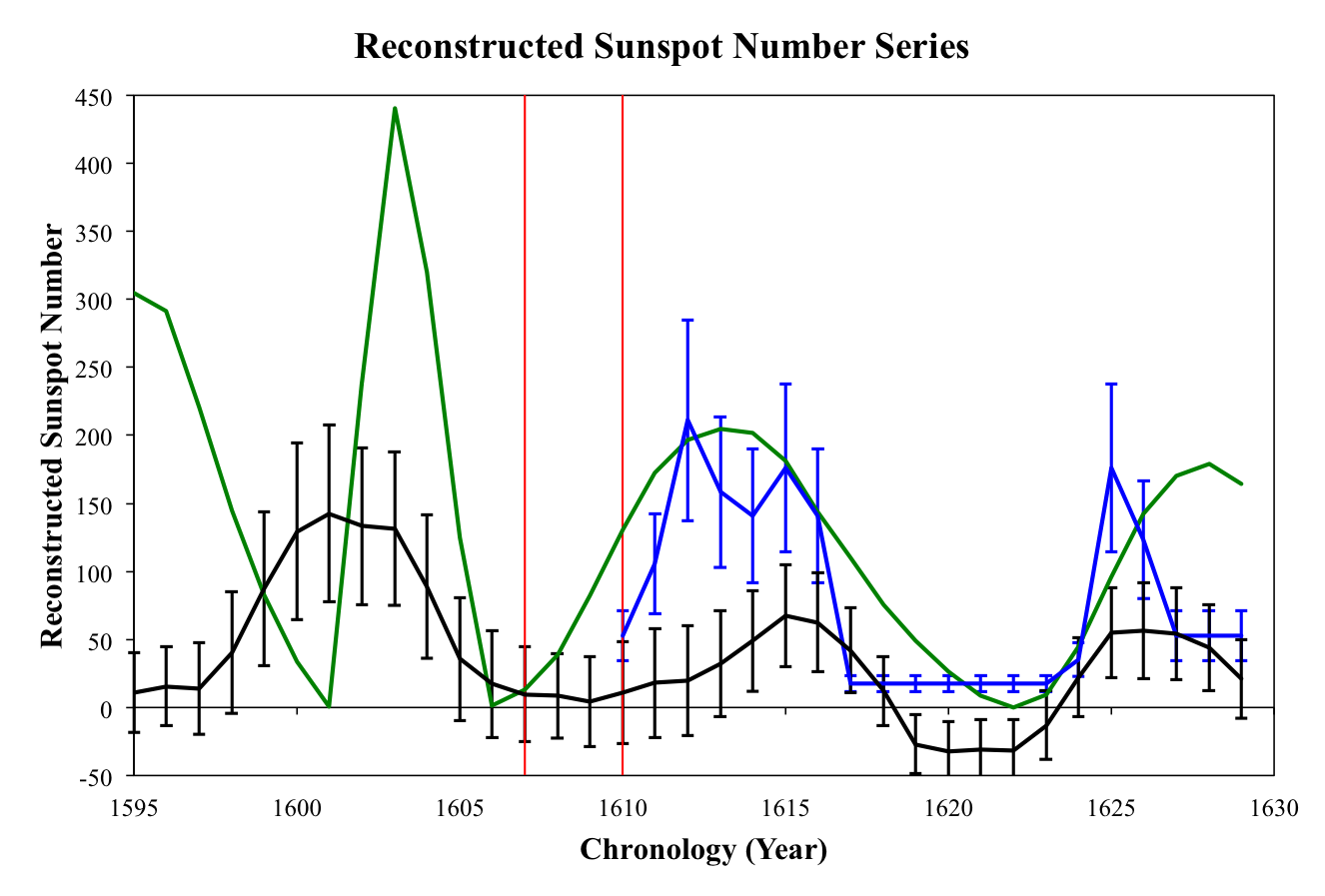Sketches of the Sun made by Johannes Kepler in 1607 may tip the scales in an important debate about the nature of solar cycles, perhaps even helping us predict future solar activity. The fact that Kepler thought he was drawing Mercury, instead of a cool patch on the Sun, doesn’t matter.
Once Galileo had used his telescope to transform our understanding of the Moon and planets, he and others turned their attention towards the much more dangerous target of the Sun. Although Chinese astronomers had recorded the existence of sunspots two thousand years before, observations by Thomas Harriot, Galileo, and Christoph Scheiner starting in 1610 provided the first records of sunspot numbers and location.
In fact, Kepler had beaten them to it, and without a telescope. Instead, he used a “camera obscura”, a device still used today both to teach about physics and to safely observe eclipses. That meant Kepler could only see the largest sunspots, but his timing turned out to be invaluable.
Since 1715, sunspot activity has risen and fallen on an 11-year cycle. Sometimes peaks come a little early or late, and their height has varied – but generally speaking, the pattern is regular enough for predictions. From 1645 to 1715 there were almost no sunspots, let alone a cycle, during what is known as the Maunder Minimum.
Debate continues about the situation before the Maunder Minimum – were the cycles similar to the current ones, or something quite different? In the former case, it suggests that 11-year cycles are the norm, even if they fade for a while. In the latter, we may be living through a rare period of stability of a usually more erratic Sun
If this was just about sunspots, that might not matter much – but we now know the sunspot cycle is correlated with geomagnetic storms that pose a major threat to satellites and electricity grids.
Tree rings provide a record of solar activity, but the precision is disputed. One reconstruction based on tree ring data identifies a cycle of just 5 years, followed by one of 16 years, in the lead-up to the Maunder Minimum.
“If true, this would indeed be interesting. However, another tree-ring-based reconstruction indicated a sequence of solar cycles with normal durations,” said study author Hisashi Hayakawa of Nagoya University in a statement. “Then, which reconstruction should we trust? It is extremely important to check these reconstructions with independent – preferably observational – records.”
It’s a question we could settle if we had a few more years of sunspot data, which is where Kepler’s sketches come in. Taken two hours apart at his house and a workshop at the citadel of Prague, they don’t provide anything like an ideal sample size, which initially led many astronomical historians to dismiss their value. Hayakawa thinks this is a mistake.
The important thing here is not that Kepler detected a sunspot, but its location. Sunspots don’t just vary in number in the course of a solar cycle; their location shifts as well. When a cycle begins, they are most common halfway between the Sun’s equator and poles, but as the cycle progresses the typical location moves ever closer to the equator.
These are averages – the small number of spots Kepler drew might have been outliers, but knowing their location could help pinpoint the timing of the cycle, particularly in combination with the more extensive sketches starting three years later.
To work this out, we not only need to assume Kepler’s drawing was accurate with the limited technology he had, but also establish the angle he was looking at to locate the Sun’s equator and poles. Thankfully, Kepler, among the most diligent of geniuses, also provided a drawing of how he made the observations.
Allowing for the angle of Kepler’s equipment, Hayakawa and colleagues have concluded Kepler’s two images represent a large sunspot group at low latitudes, statistically far more likely near the end of a cycle. Had he bothered to look again a year or two later, the authors suspect, his chance of seeing a spot would have been low.
If this is right, allowing for considerable uncertainty, it suggests the cycle Galileo and others witnessed (known as -13 by counting back from 1755 when a peak was first recognized) was of regular length. That would strengthen the idea that cycles before the Maunder Minimum were similar to those today.

Reconstruction of the number of sunspots in the years before the Maunder Minimum by adding Kepler’s data to the observations made after the invention of the telescope.
Image Credit: Dr Hisashi Hayakawa
“As one of my colleagues told me, it is fascinating to see historical figures’ legacy records convey crucial scientific implications to modern scientists even centuries later,” said co-author Sabrina Bechet of the Royal Observatory of Belgium. “I doubt if they could have imagined their records would benefit the scientific community much later, well after their deaths. We still have a lot to learn from these historical figures, apart from the history of science itself. In the case of Kepler, we are standing on the shoulders of a scientific giant.”
It’s a little ironic the space telescope named in Kepler’s honor had the task of observing the transits of distant planets across their stars, and distinguishing these from star spots, given he at first thought he was seeing Mercury. In fact, he was two years late to witness the innermost planet against the Sun and acknowledged his error in 1618 once sunspots were better known.
However, given the scientific gold Kepler spun from that mistake, perhaps the telescope is better named than we knew.
The study is published open access in The Astrophysical Journal Letters.
Source Link: Kepler’s Sunspot Sketches Could Solve A Longstanding Solar Mystery Four Centuries Later